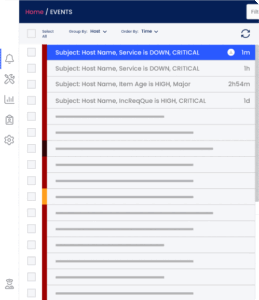Network Operations Centers (NOCs) provide companies with a central location to monitor and maintain their infrastructure and the performance and availability of their cloud solution/application. While it may be used differently from company to company, with some not even calling it a NOC, the end-goal is always to maintain optimal and round-the-clock availability across platforms, mediums, and channels..
As more services and applications are introduced and migrated to the cloud, NOCs are under a great deal of pressure to meet the growing technical and business service demands of SaaS companies. Today, NOCs are becoming part of companies’ core business strategies, requiring larger investments in human capital and technology for efficient implementation and management.
NOC management involves a number of challenges that must be acknowledged in order to overcome them and ensure efficient business operations 24/7.
5 key challenges in NOC Management
- Monitoring without Observability DevOps teams deal with growing workloads, and current monitoring systems aggregate increasingly more data at higher frequencies. As more applications, microservices, and components enter the picture, developers are overwhelmed with the number of metrics and alerts they have to monitor. As a result, issues are not resolved quickly, the user experience is compromised, increased resources are spent on fixing problems, the chances of human error or important issues falling through the cracks rise, and more.
- No Centralized Runbook Management A runbook (sometimes called “playbook”) is essentially a knowledge base that is constantly being updated with instructions on how to classify alerts and the actions that need to be carried out to resolve them. Since engineers often face the same type of incidents that require similar if not identical actions, creating and managing a runbook can make the process shorter and more effective. Without a centralized runbook to manage all of the knowledge in one place, companies use “knowledge silos” that can lead to lost knowledge, longer resolution times and downtimes, reliance on specific engineers and developers in the company, inefficient communication between teams and departments, and significantly increased damage and costs.
- Automation without Human Intervention NOC teams face numerous tasks on a regular basis, from monitoring different dashboards and platforms and proactive task scheduling to reporting to internal departments and external customers. All of this requires time-consuming manual work, and automation is key to reducing their workload so that they can focus on more important things within the company. However, there are also risks involved that need to be addressed in order to leverage what automation can offer. While certain things can be automated to complete tasks and resolve issues faster, there will come a time that the automated system will come across a bug or a situation it does not recognize, and that is where something can go wrong. Truly effective automation involves a hybrid of both machine automation and human intervention to function reliably.
- Lack of Communication and Collaboration between Departments When a NOC is not fully and constantly updated, changes in shifts and employees introduce the risk of miscommunication, issues falling through the cracks, and human error. Effective work requires that everyone and everything is properly synchronized (NOC, DevOps, development, management, etc.). Communication is reflected in things like updates, remediation processes, on-call escalations, and more – all of which require an open communication channel between all departments and employees.
- Inefficient 24/7/365 NOC Management Uptime management is dependent on 24/7 NOC operations, and is a set of services and tools designed for controlling, monitoring, and optimizing operational productivity to ensure optimal availability at all times. This is especially critical in today’s cloud-based world and the constant demand for round-the-clock uptime at optimal speeds. Cloud-based infrastructures are often built with a large number of systems geared for elastic scalability, while hardware costs should be kept to a minimum. Without proper 24/7/365 uptime management, companies are unable to avert emerging issues, solve critical situations, and reduce downtime efficiently. Furthermore, 24/7 NOC management with real-time monitoring is critical to ensure issues are identified and addressed as quickly as possible. This is challenging, as it requires companies to invest in human resources, comfortable working environments, NOC training and certification, performance analyses and measurements (SLA, escalation quality, etc.), and additional measures to ensure NOC engineers are always sharp and motivated to take quick action when needed.
What challenges have you faced in your daily NOC operations? let us know at sales@moovingon.com


